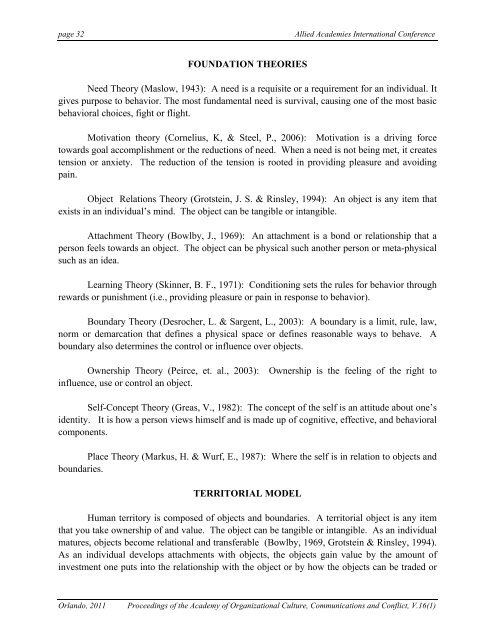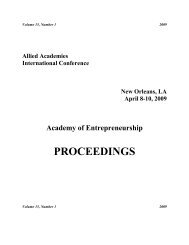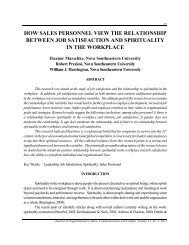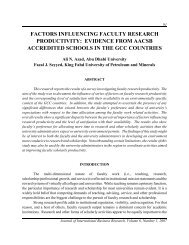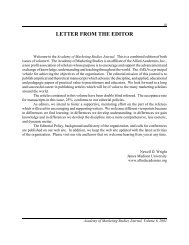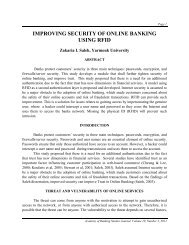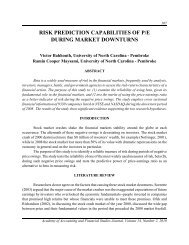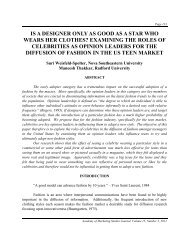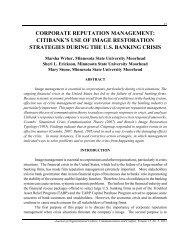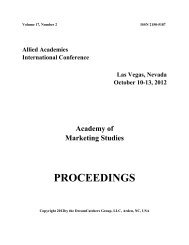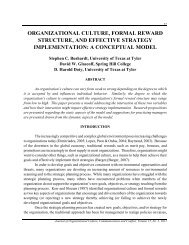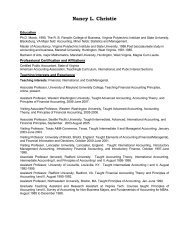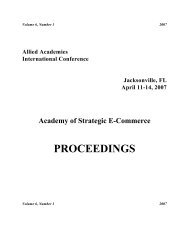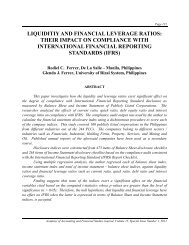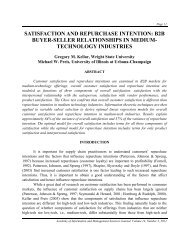AOCCC - Allied Academies
AOCCC - Allied Academies
AOCCC - Allied Academies
You also want an ePaper? Increase the reach of your titles
YUMPU automatically turns print PDFs into web optimized ePapers that Google loves.
page 32<br />
<strong>Allied</strong> <strong>Academies</strong> International Conference<br />
FOUNDATION THEORIES<br />
Need Theory (Maslow, 1943): A need is a requisite or a requirement for an individual. It<br />
gives purpose to behavior. The most fundamental need is survival, causing one of the most basic<br />
behavioral choices, fight or flight.<br />
Motivation theory (Cornelius, K, & Steel, P., 2006): Motivation is a driving force<br />
towards goal accomplishment or the reductions of need. When a need is not being met, it creates<br />
tension or anxiety. The reduction of the tension is rooted in providing pleasure and avoiding<br />
pain.<br />
Object Relations Theory (Grotstein, J. S. & Rinsley, 1994): An object is any item that<br />
exists in an individual’s mind. The object can be tangible or intangible.<br />
Attachment Theory (Bowlby, J., 1969): An attachment is a bond or relationship that a<br />
person feels towards an object. The object can be physical such another person or meta-physical<br />
such as an idea.<br />
Learning Theory (Skinner, B. F., 1971): Conditioning sets the rules for behavior through<br />
rewards or punishment (i.e., providing pleasure or pain in response to behavior).<br />
Boundary Theory (Desrocher, L. & Sargent, L., 2003): A boundary is a limit, rule, law,<br />
norm or demarcation that defines a physical space or defines reasonable ways to behave. A<br />
boundary also determines the control or influence over objects.<br />
Ownership Theory (Peirce, et. al., 2003): Ownership is the feeling of the right to<br />
influence, use or control an object.<br />
Self-Concept Theory (Greas, V., 1982): The concept of the self is an attitude about one’s<br />
identity. It is how a person views himself and is made up of cognitive, effective, and behavioral<br />
components.<br />
Place Theory (Markus, H. & Wurf, E., 1987): Where the self is in relation to objects and<br />
boundaries.<br />
TERRITORIAL MODEL<br />
Human territory is composed of objects and boundaries. A territorial object is any item<br />
that you take ownership of and value. The object can be tangible or intangible. As an individual<br />
matures, objects become relational and transferable (Bowlby, 1969, Grotstein & Rinsley, 1994).<br />
As an individual develops attachments with objects, the objects gain value by the amount of<br />
investment one puts into the relationship with the object or by how the objects can be traded or<br />
Orlando, 2011<br />
Proceedings of the Academy of Organizational Culture, Communications and Conflict, V.16(1)


